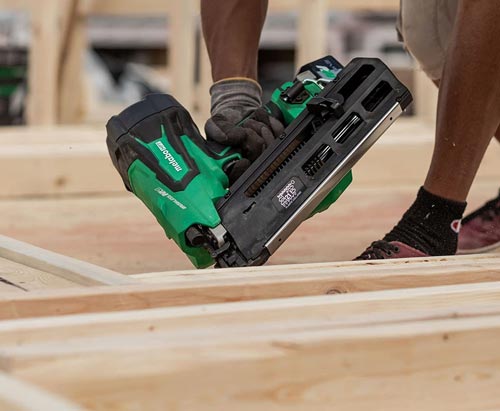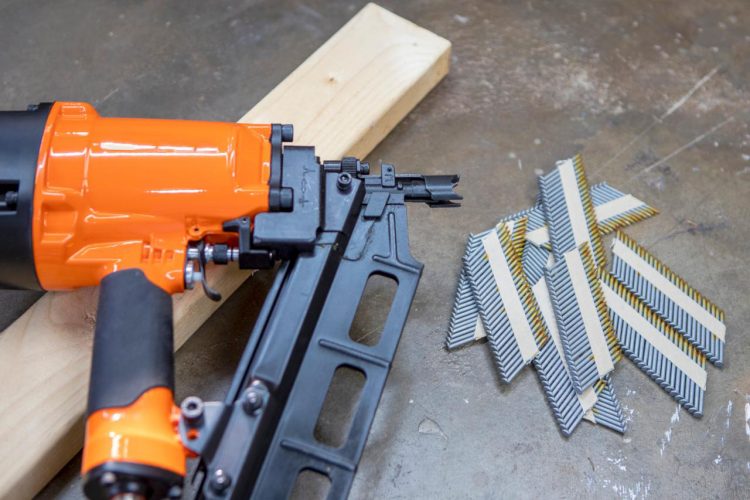The world has experienced a rapid change accompanied by lots of technological improvements. Today people no longer do things manually since there are tons of machines and tools out there that can assist with different tasks. One of this tool is called the framing nailer.
This is also referred to as a nail gun. The tool was first used by Morris Pynoos, who was a civil engineer. The first framing nailer was introduced in the year 1950, and then it was strictly used for flooring purposes, and was operated with the use of air pressure. You can use it to nail up 40 to 55 nails in a minute and fill it up with up to 600 nails. So, you can imagine how fast it was when compared to the use of hammers.
Over the years, the framing nailer has experienced a significant change that creates room for different nailers. All guns have different power ranges and can be employed for different types of jobs.
That being said, we know how difficult this can be when you intend to get a nail gun that suits your needs. This is one of the reasons we created this comprehensive guide to the subject matter nail gun. In this article, we will be looking at different features and how to use and ensure safety during the entire process.
What Is a Framing Nailer?

The framing nailer, also known as the gun nailer, is a work tool designed to attach to different pieces of wood together with the aid of a nail. The device has a similar shape to that of a gun. Using the tools has served a better alternative to the use of framing hammers when carrying out project on woodwork.
The tool saves hours of work time when carrying out any project that involves nailing.
Before choosing a nail gun, it is vital to consider the current task at hand. You will need to consider the texture, size, and quality of what you intend nailing.
When Should You Use A Nail Gun?
Usually, nails are designed handy, irrespective of the project you intend to work on. Although some are preferable when it comes to high volumes duty. For instance, the framing nail is a perfect example of such, while some are suitable for smaller jobs and heavy-duty project too.
When you intend to take on any job, it essential to understand the different types of nailers in the market. You can also go as far as knowing the nail size that is suitable for the project since all the nails have their sets of benefits and features.
Finally, before starting, we recommend taking out some time to learn all the steps involved when using the framing nailer. Below is a step by step guide on how this is done.
How to Use a Framing Nailer?

The nail gun can be a dangerous weapon if not handled carefully. In handling the tool, it essential to take proper caution similar to the way you would if you were holding a gun.
With the above safety guidelines in mind, below are some measures you can adhere to irrespective of the type of gun you have for the job.
Now that we have taken some steps to know some safety measures, below are mentioned steps, you can adhere to get started.
1. Have your glasses and gloves
Safety, safety, safety can be an essential standard to hold yourself to when working. It is important to adhere to all forms of precautions. The first step here is to put on your gloves and glasses before adding up nails in the gun.
2. Strip Loading
You will need to position the strips of nails in the gun magazine. Normally, the gun magazine is located at the bottom or on the rear part of the nailer, though the position depends greatly on the type of gun used.
If you want to load the nail strip, you will need to slide in the strip and then close down the magazine once you observe all the nails are entirely secured.
3. Practice Shooting
Taking time to do some practice with the nail gun is vital, especially for beginners –who are yet to familiarize themselves with the entire process. We recommend firing on a block of old wood or any wooden material to get used to how it works.
4. Position the Gun on the Material
Now that you’re used to it, position it on directly on the surface you intend nailing. Ensure the handle is rightly held so that you can easily access the trigger. Safely position your fingers and hands and try to put it away from the fire zone.
You will need to use the whole of your body to create enough pressure and stability to withstand the kickback that comes from the gun once a nail is fired.
5. Put Pressure
Once you try to add pressure on the nailer, it is important to bear in mind that positioning the nailer in the direction of your stomach or chest can lead to severe injuries.
Most importantly, it is essential to know that the nailer gun operates with a kickback force. Once a nail is shot, let’s go of the trigger immediately, failure to do this will lead to more shots of nails.
6. Take the Gun Away
Once the nailer gun is off the surface where you took the first shot, check out the nail to ensure it is flushed with the surface. If it is not flushed enough, then it’s possible the gun was pulled off from the surface faster than the usual time frame.
7. Disconnect and Reload the Strip
Once you’re ready for another round, you will need to disconnect the framing nailer directly from the source of power. Do this before loading more nails in the magazine.
Conclusion
Before you choose a preferred nailer, knowing their uses will be recommended. Understanding its mode of operation can ensure your safety.
Finally, you will need to choose the right manufacturers who are known for quality designs and durable products. Although making such decisions can sometimes be pretty demanding due to the tons of products out there.
FAQ’s
Q. 1: How does a framing nailer work
Ans: The framing nailer operates with the use of air compressors; the tool delivers air directly into the device via a lengthy hose. Once the framing nailer drives in a nail, the air that was compressed in the hose directs the tool piston –which leads the nail straight to the wood.
Q. 2: What can you use a framing nailer for?
Ans: The framing nailer can be used for constructing buildings, roof sheathing, and Fencing. For most heavy-duty carpentry jobs like deck building, and plaster works.
Q. 3: How do you use a nailgun?
Ans:
- Ensure you have enough nail loaded into the gun’s magazine.
- Have your gloves and safety glasses on, then turn on the power.
- Take out some time to practice shooting on scraps before the start of any project.
- Position the tip of the nailer gun directly on the surface you intend nailing.
- Hold down the tip of the gun directly on the surface and exert some pressure on it.
Q. 4: What size nails does a framing nailer use?
Ans: The framing nailer makes use of a thicker angle nail which size range from 1 ½ inch to 3 ½ inches. Although we recommend the use of 3 inches sized minimum nail. Finishing nailers, when compared to the thinner, appears to be more bit thinner than most framing nails, since the nails are designed for precision and lighter jobs.








